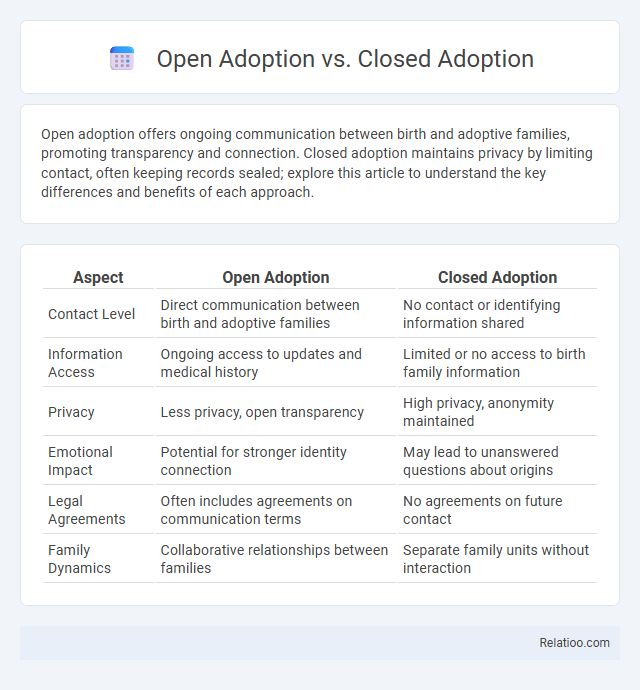Open adoption offers ongoing communication between birth and adoptive families, promoting transparency and connection. Closed adoption maintains privacy by limiting contact, often keeping records sealed; explore this article to understand the key differences and benefits of each approach.
Table of Comparison
| Aspect | Open Adoption | Closed Adoption |
|---|---|---|
| Contact Level | Direct communication between birth and adoptive families | No contact or identifying information shared |
| Information Access | Ongoing access to updates and medical history | Limited or no access to birth family information |
| Privacy | Less privacy, open transparency | High privacy, anonymity maintained |
| Emotional Impact | Potential for stronger identity connection | May lead to unanswered questions about origins |
| Legal Agreements | Often includes agreements on communication terms | No agreements on future contact |
| Family Dynamics | Collaborative relationships between families | Separate family units without interaction |
Understanding Open Adoption
Open adoption fosters direct communication and contact between birth parents and adoptive families, enhancing transparency and emotional connection. This approach contrasts with closed adoption, where no identifying information or contact is shared, often leading to limited knowledge about biological origins. Understanding open adoption involves recognizing its benefits for identity development, medical history access, and maintaining ongoing relationships.
Defining Closed Adoption
Closed adoption is a type of adoption process where the birth parents and adoptive parents have no contact or identifying information exchanged, ensuring privacy and confidentiality. This adoption model contrasts with open adoption, where communication and contact between both parties are maintained. Understanding closed adoption is crucial for adoptees seeking information about their heritage or birth family, as access to records and interactions are legally restricted.
Key Differences Between Open and Closed Adoption
Open adoption facilitates direct contact between birth parents and adoptive families, allowing ongoing communication and relationship-building, while closed adoption maintains confidentiality by sealing birth records and limiting information exchange. Your choice between open and closed adoption impacts the child's understanding of biological roots and access to medical history. Open adoption offers transparency and connection, whereas closed adoption emphasizes privacy and legal separation.
Pros of Open Adoption
Open adoption fosters transparency by allowing birth parents and adoptive families to maintain communication, which can enhance the child's sense of identity and emotional security. It provides access to medical histories and cultural backgrounds, contributing to informed healthcare decisions and personal development. This model often reduces feelings of abandonment for the child and strengthens familial bonds through ongoing connections.
Pros of Closed Adoption
Closed adoption offers increased privacy and confidentiality by keeping the birth parents' and adoptive family's identities undisclosed, which can provide emotional security for all parties. Your personal information is protected, reducing potential conflicts or emotional complications later in life. This type of adoption can create a clear separation between birth and adoptive families, allowing adoptees to form their identity without external influence.
Challenges of Open Adoption
Open adoption presents unique challenges such as managing ongoing communication between birth parents and adoptive families, which can lead to complex emotional boundaries. You may face difficulties balancing transparency with privacy, especially when addressing differing expectations or potential conflicts. Unlike closed adoption, where information is limited, open adoption requires navigating continuous relationships that demand emotional resilience and clear agreements.
Challenges of Closed Adoption
Closed adoption presents unique challenges including limited access to medical history and biological family information, which can impact your ability to understand genetic health risks and personal identity. Unlike open adoption, where communication and contact are maintained between birth and adoptive families, closed adoption strictly seals records, making it difficult to establish connections or resolve emotional questions. This lack of transparency can lead to feelings of uncertainty and identity struggles for adoptees and adoptive families alike.
Impact on Birth Parents
Open adoption allows birth parents ongoing access to information and connection with the child, promoting emotional closure and involvement in the child's life. Closed adoption restricts contact and knowledge between birth parents and adoptive families, often leading to feelings of loss and unanswered questions. Your choice influences how much support and communication you maintain, affecting your long-term emotional well-being.
Effects on Adoptive Families
Open adoption promotes transparency and ongoing contact between birth families and adoptive families, fostering emotional bonds and easing identity questions for the child. Closed adoption limits information exchange, which can create uncertainties or challenges in communication within adoptive families. Your family's dynamics and emotional well-being may benefit from the openness of adoption arrangements, impacting long-term relationships and support systems.
Deciding Which Adoption Type Is Right for You
Deciding which adoption type is right for you depends on your preferences for openness and contact with birth families. Open adoption allows ongoing communication and information exchange, fostering transparency and relationship building, while closed adoption maintains confidentiality with no contact or identifying information shared. Assessing your comfort level with openness, desire for birth family involvement, and long-term emotional considerations is essential in making the best choice between open, closed, or semi-open adoption arrangements.

Infographic: Open Adoption vs Closed Adoption
 relatioo.com
relatioo.com